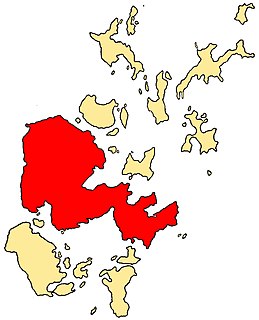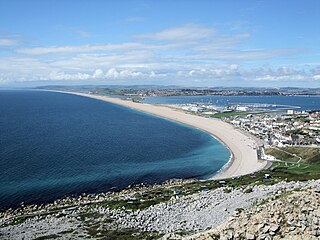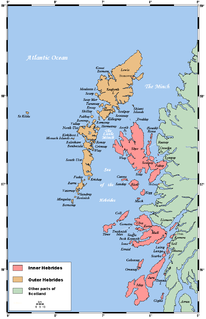
Fair Isle is an island in Shetland, in northern Scotland. It lies about halfway between mainland Shetland and Orkney. It is known for its bird observatory and a traditional style of knitting. The island has been owned by the National Trust for Scotland since 1954.

Shetland, also called the Shetland Islands and formerly Zetland, is a subarctic archipelago in the Northern Atlantic, between Great Britain, the Faroe Islands and Norway. It is the northernmost part of the United Kingdom.

St Kilda is an isolated archipelago situated 64 kilometres (40 mi) west-northwest of North Uist in the North Atlantic Ocean. It contains the westernmost islands of the Outer Hebrides of Scotland. The largest island is Hirta, whose sea cliffs are the highest in the United Kingdom; three other islands were also used for grazing and seabird hunting. The islands are administratively a part of the Comhairle nan Eilean Siar local authority area.

The fulmars are tubenosed seabirds of the family Procellariidae. The family consists of two extant species and two extinct fossil species from the Miocene.

The European rock pipit, or just rock pipit, is a species of small passerine bird that breeds in western Europe on rocky coasts. It has streaked greyish-brown upperparts and buff underparts, and is similar in appearance to other European pipits. There are three subspecies, of which only the Fennoscandian form is migratory, wintering in shoreline habitats further south in Europe. The European rock pipit is territorial at least in the breeding season, and year-round where it is resident. Males will sometimes enter an adjacent territory to assist the resident in repelling an intruder, behaviour only otherwise known from the African fiddler crab.

Foula, located in the Shetland archipelago of Scotland, is one of the United Kingdom’s most remote permanently inhabited islands. Owned since the turn of the 20th century by the Holbourn family, the island was the location for the film The Edge of the World (1937). The liner RMS Oceanic was wrecked on the nearby Shaalds of Foula in 1914.

The house wren is a very small songbird of the wren family, Troglodytidae. It occurs from Canada to southernmost South America, and is thus the most widely distributed native bird in the Americas. It occurs in most suburban areas in its range and it is the single most common wren. Its taxonomy is highly complex and some subspecies groups are often considered separate species. The name troglodytes means "hole dweller", and is a reference to bird's tendency to disappear into crevices when hunting insects or to seek shelter.

The Mainland, also known as Hrossey and Pomona, is the main island of Orkney, Scotland. Both of Orkney's burghs, Kirkwall and Stromness, lie on the island, which is also the heart of Orkney's ferry and air connections.

A storm beach is a beach affected by particularly fierce waves, usually with a very long fetch. The resultant landform is often a very steep beach composed of rounded cobbles, shingle and occasionally sand. The stones usually have an obvious grading of pebbles, from large to small, with the larger diameter stones typically arrayed at the highest beach elevations. It may also contain many small parts of shipwrecked boats.

Troglodytes is a genus of small passerine birds in the wren family. These wrens are around 11–13 centimetres (4.3–5.1 in) long. They are brownish above and somewhat paler below, with strong legs. Their short rounded wings and frequently cocked tail have a dark barred pattern. The flight is direct and buzzing.

The Antarctic tern is a seabird in the family Laridae. It ranges throughout the southern oceans and is found on small islands around Antarctica as well as on the shores of the mainland. Its diet consists primarily of small fish and crustaceans. It is very similar in appearance to the closely related Arctic tern, but it is stockier, and it is in its breeding plumage in the southern summer, when the Arctic tern has shed old feathers to get its non-breeding plumage. The Antarctic tern does not migrate like the Arctic tern does, but it can still be found on a very large range. This tern species is actually more closely related to the South American tern.

Cobb's wren is a fairly small (12-13.5 cm) wren which is endemic to the Falkland Islands. It was formerly classified as a subspecies of the house wren but is now commonly considered to be a separate species due to differences in plumage, voice, ecology and morphology.

The fauna of Scotland is generally typical of the northwest European part of the Palearctic realm, although several of the country's larger mammals were hunted to extinction in historic times and human activity has also led to various species of wildlife being introduced. Scotland's diverse temperate environments support 62 species of wild mammals, including a population of wild cats, important numbers of grey and harbour seals and the most northerly colony of bottlenose dolphins in the world.

The flora and fauna of the Outer Hebrides in north west Scotland comprises a unique and diverse ecosystem. A long archipelago, set on the eastern shores of the Atlantic Ocean, it attracts a wide variety of seabirds, and thanks to the Gulf Stream a climate more mild than might be expected at this latitude. Because it is on the Gulf Stream, it also occasionally gets exotic visitors.

The St Kilda wren is a small passerine bird in the wren family. It is a distinctive subspecies of the Eurasian wren endemic to the islands of the isolated St Kilda archipelago, in the Atlantic Ocean 64 kilometres (40 mi) west of the Outer Hebrides, Scotland.
The Shetland wren is a small passerine bird in the wren family. It is a subspecies of the Eurasian wren endemic to the Shetland archipelago of Scotland, with the exception of Fair Isle which has its own endemic subspecies, the Fair Isle wren. The Shetland wren is distinguished by its darker and more rufous-brown colouring from the mainland form, with a heavily barred underside, the barring extending from belly to breast. The bill is stouter and longer and it has stronger legs.

The Scottish Dunface, Old Scottish Short-wool, Scottish Whiteface or Scottish Tanface was a type of sheep from Scotland. It was one of the Northern European short-tailed sheep group, and it was probably similar to the sheep kept throughout the British Isles in the Iron Age. By the mid-nineteenth century it had mostly been displaced by the Scottish Blackface and it became extinct on the mainland of Scotland in the late nineteenth century. However, several local types of Dunface survived on islands around Scotland, giving rise to or contributing to existing breeds including the Shetland, North Ronaldsay, Hebridean and Boreray.

The Eurasian wren is a very small insectivorous bird, and the only member of the wren family Troglodytidae found in Eurasia and Africa (Maghreb). In Anglophone Europe, it is commonly known simply as the wren. It has a very short tail which is often held erect, a short neck and a relative long thin bill. It is russet brown above, paler buff-brown below and has a cream buff supercilium. The sexes are alike.
















